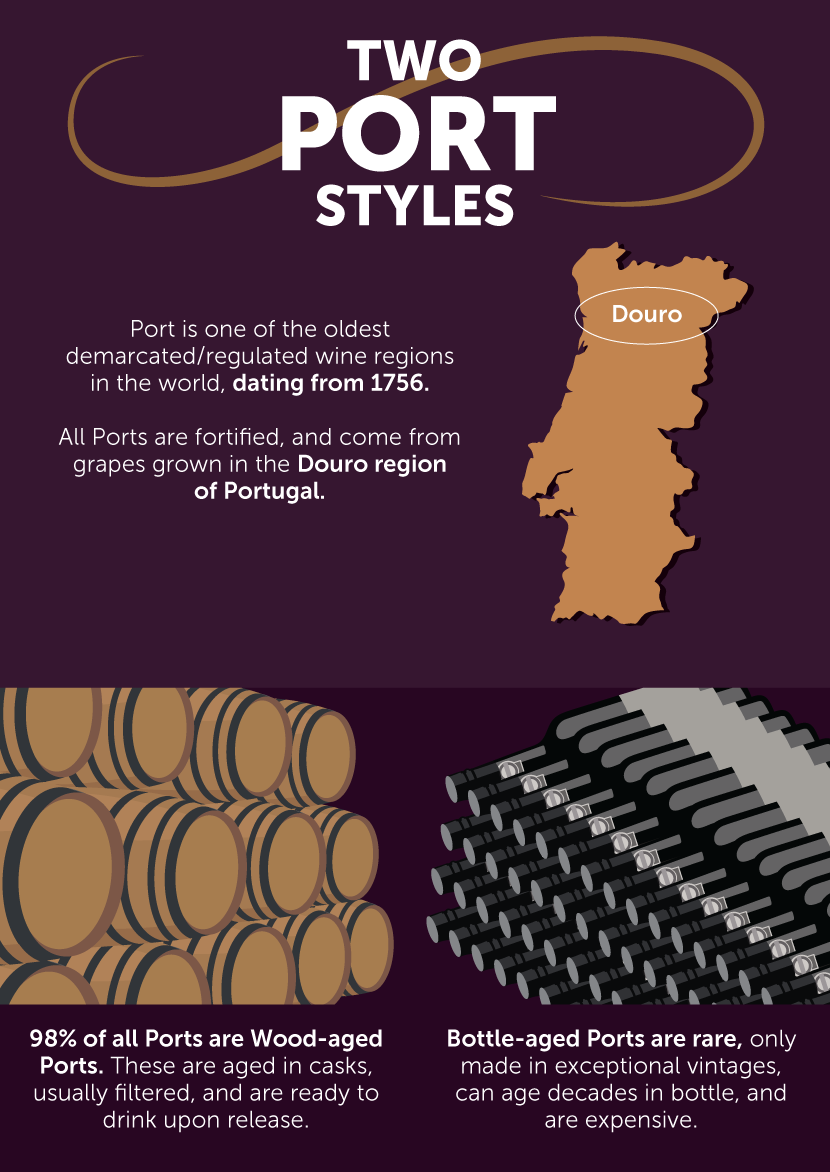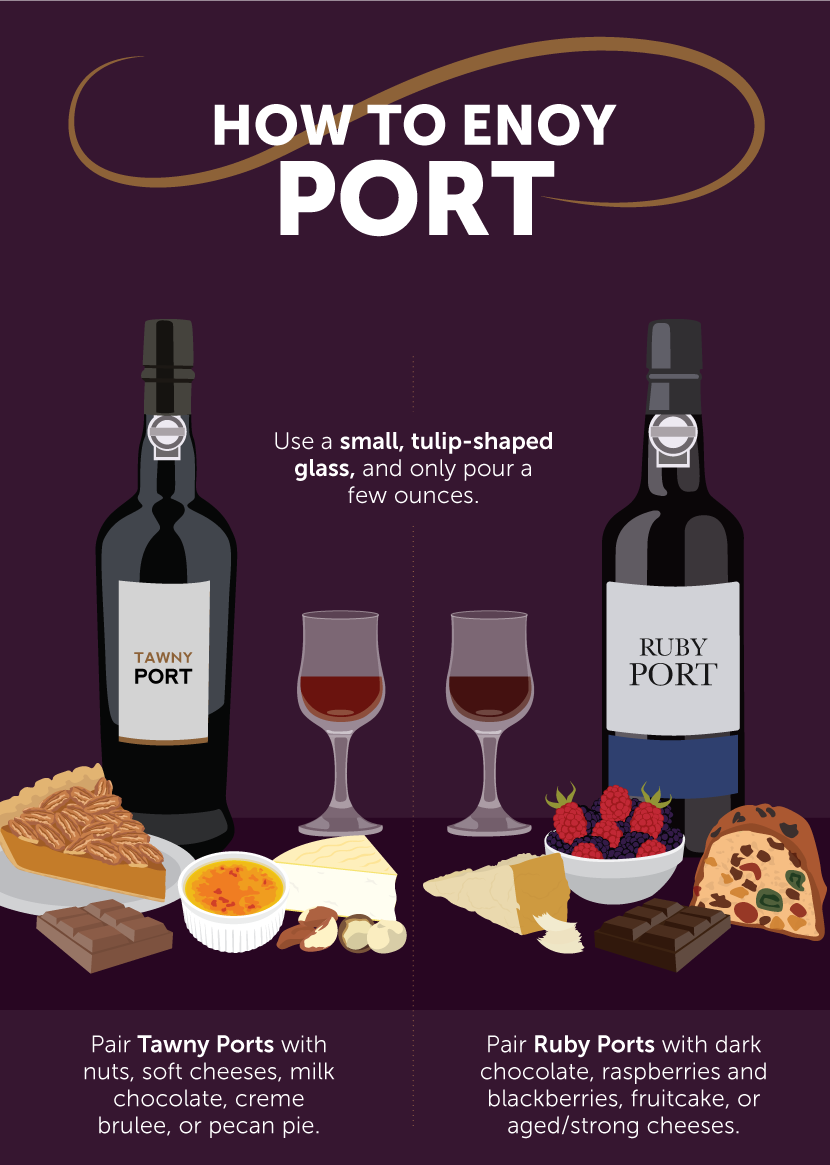
Get your fix of expert articles delivered straight to your inbox!
No Thanks - I don't like cool stuff

Port – the real stuff, from grapes grown in the terraced vineyards of the Douro and made into wine in and around Porto in Portugal – is one of the wine world’s oldest and most interesting pleasures.
Port vineyards are one of the oldest demarcated and regulated farming areas in the world, and with over 250 years of history, you’d expect the wines to be beguiling, and you’d be right. With over two and a half centuries of European lawmaking behind them, you might also expect port wines to be totally confusing, and you’d be right about that, too. Port vineyards undergo a multipoint quality classification and rating for each plot, and that’s not even considering the final style and quality of the producers who turn the stuff into wine. Don’t start sweating, though, because we’re about to make your next foray into the tasty realm of this dessert wine a whole lot easier.
The key to understanding port is to realize that there are really only two styles. That might shock anyone who has shopped for port in the wine aisle for more than three minutes and been bombarded by a seemingly endless display of port types, but it’s true. Ports are either wood-aged, which makes up around 98 percent of all the types of port you’ll encounter, or bottle-aged – these are special, and have the high prices to match. That’s it. Really. Trust us, it will all make sense in a few minutes!

First, let’s talk about what all ports have in common. Ports are made from a blend of several grapes, the most important being Touriga Nacional, Touriga Franca, Tinta Roriz (more commonly known as Tempranillo), Tinta Barroca, and Tinta Cao. Port is fortified, which means that a neutral grape spirit is added to the wine as it’s fermenting, killing off the active yeasts, stabilizing the wine, and stopping fermentation before all of the grape sugars can be converted into alcohol. This process gives port its punch of typically around 20 percent alcohol by volume and its lively sweetness – a product of the natural sugars left over in the grapes.
Almost all port is bottled after it ages in wood casks, after which it’s filtered, bottled, and ready to drink right off the shelf. Because the wood-aging process gently exposes the wine to air, wood-aged ports tend to have a relatively long shelf life after being opened – two weeks or more. Here are the wood-aged ports that you’re most likely to encounter.
Ruby – This is where most of us start when it comes to port. Aged for three years, it’s simple, smooth, good with dark chocolate, and full of grape and sweet plum flavors and aromas.
Reserve – Reserve ports are the standard-bearers for the most famous port production houses, and are essentially ruby ports made from higher-quality grapes and aged longer (4-6 years). Usually, they have richer, plummier fruit than standard rubies, are darker, and have more chocolate aromas.
Tawny – Also aged for three years, this type of port is named after its caramel color, which comes from shorter skin contact during fermentation. These ports are nutty, mellow, rich, and a good match for milk chocolate or pecan pie.
Aged Tawny – These come in increasing average ages (10, 20, 30, and 40 years), the oldest being the rarest and most expensive. As they age longer in casks, tawny ports have drier fruit flavors, are nuttier, more sherry-like, more complex, and feature fig, rum, and spice aromas. They are more deeply concentrated. These ports are usually reserved for very high-quality grapes.
Late-Bottled Vintage – This is one of the most fun port categories. While it carries a vintage date, it’s not technically a vintage port; it’s kind of a vintage port with training wheels. These ports are aged four to six years, and can then age a bit longer in bottle to become softer and more complex, with wood spice aromas and dark plum flavors. The “standard” style can be enjoyed right away, while the “traditional” style isn’t filtered, so it can carry sediment and needs decanting before serving.
White – While many variations of this port type exist, almost all are made from white grapes, are slightly sweet, and are meant to be consumed chilled as an aperitif. They are the key ingredient in the portini cocktail.

Reserve Tawny – This type of tawny is best thought of as being “in between” standard tawny and aged tawny. Generally, it’s made by shippers who decide to age their tawnies in casks beyond the minimum aging requirements, but for less time than would be required for a 10-year tawny. The result is a nice middle ground between the figgy fruit of standard tawny port and the dried fruit and nut flavors of a 10-year tawny.
Colheita – This is a rare category, made from a single harvest like vintage port but aged in cask like a tawny for seven years or more. They are filtered, so they’re ready to consume when purchased, and can be thought of as a very high-quality, concentrated, aged tawny port.
Bottle-aged ports are rare, expensive, celebrated wines, because they can only be made in exceptional harvest years. They’re worth saving for, however, because they are among the best wines in the world, and can age gracefully in the bottle for decades.
Vintage – These are basically ruby ports that are made from the best grapes in the best years, and see very little cask aging before being bottled. When you have an exceptional one, you will likely never forget it. Complex, beguiling, smooth, and fresh, vintage ports have spice and pepper aromas and blueberry, grape, and plum fruit flavors, with depth and concentration that you only find in the world’s finest wines.
Single Quinta Vintage – This category is vintage port’s little brother. They are made from excellent grapes in years that are almost good enough to produce a vintage port. Otherwise, the production process is identical to a vintage; the main difference is that single quinta vintage ports won’t have quite the longevity or complexity of a full-on vintage. They are usually less expensive than vintage ports, and are a great option for getting your vintage port feet wet.
There are very good reasons why port has been around so long. Few dessert wines combine natural sweetness, vibrant acidity, and so much versatility. If you’re a dessert wine fan, there’s almost certainly a type of port out there for your tastes.

When enjoying port, try matching it up with different foods, and contrast elements where you can. For example, the mellow flavors of tawny port work well with stronger, creamier foods like milk chocolate, caramel, and softer cheeses. Ruby port has a great contrast when paired with bitter, dark chocolate, and helps to tame the stronger flavors of aged and blue cheeses.
The most important thing to remember is to go easy; ports are strong, bold wines, with a lot of alcoholic power, so a little goes quite a long way.
Written by:

Get your fix of expert articles delivered straight to your inbox!
No Thanks - I don't like cool stuff